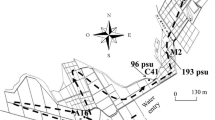Abstract
The benthic community structure of the southernmost part of Samborombon Bay was studied at 13 stations for 2 yr. A detailed examination of the zoobenthos, using similarity indices and cluster analysis, is presented. The area was characterized by low diversity. The Shannon-Weaver information diversity index H′ showed low values of 0.28–1.60. The brackish part of the area was dominated by two opportunistic polychaetes species,Heteromastus similis andLaeonereis acuta. The only species found in the transitional marine zone was the bivalveMesodesma mactroides. Variability in benthic community has been interpreted in terms of spatial and temporal changes. Depending on the area, abundance appeared to be controlled by pollution and intense predation during the warmer months. The observed gradient in species composition and dominance of these benthic communities are compared with some other North and South Atlantic estuaries.
Similar content being viewed by others
Literature Cited
Bastida, R. O., A. Roux, C. Bremec, M. Gerpe, andM. Sorensen. 1991. Estructura poblacional de la almeja amarilla (Mesodesma mactroides) durante el verano de 1989 en la Provincia de Buenos Aires, Argentina.Frente Marítimo 9 Sec. A: 83–92.
Bértola, G. R., H. Masone, andM. Osterrieth. 1993. Estudio geológico integral de Punta Rasa, Cabo San Antonio, Provincia de Buenos Aires.Serie Situación Ambiental de la Provincia de Buenos Aires (CIC) 25:1–28.
Bemvenuti, C. E., 1987. Macrofauna bentónica da regiao estuarial da lagoa Dos Patos, rs, Brasil. Simposio sobre ecosistemas da costa sul e sudeste brasileira.Publicación Aciesp 54:428–459.
Boschi, E. E. 1964. Los crustáceos decápodos brachyura del litoral toral bonaerense (R. Argentina).Boletín del Instituto de Biología Marina 6:1–99.
Boschi, E. E. 1982. Investigaciones biológico pesqueras del ecosistema costero bonaerense. Simposio Internacional sobre utilizacao de ecosistemas Costeiros, planejamento, poluicao e produtiuidade.Atlantica Rio Grande 5:1–5.
Cadée G. C. 1979 Sediment reworking by the polychaeteHeteromastus filiformis on a tidal flat in the Dutch Wadden Sea.Netherlands Journal of Sea Research 13:441–456.
Capitoli, R. R., C. Bemvenuti, andN. Gianuca. 1978. Estudos de ecologia bentonica na regiao estuarial de Lagoa Dos Patos. 1—As comunidades bentonicas.Atlantica 3:5–22.
Czekanowski, J. 1913. Zarys Metod. Statystycznyck. Warsaw, Poland.
Defeo, O. andV. Scarabino. 1990. Ecological significance of a possible deposit-feeding strategy inMesodesma mactroides (Deshayes, 1854) (Mollusca: Pelecypoda).Atlantica 12:55–65.
Dice, L. R. 1945. Measures of the amount of ecological association between species.Ecology 26:297–302.
Elias, R. 1992. Quantitative benthic community structure and its relationship with organic enrichment.Marine Ecology 13: 189–201.
Elias, R. andC. Bremec. 1994. Biomonitoring of water quality using benthic communities in Blanca Bay (Argentina).The Science of the Total Environment 158:45–49.
Elias, R. andE. Ieno. 1993. La Asociación deLaeonereis acuta Treadwell, 1923 (Polychaeta, Nereididae) en la Bahía Blanca, Argentina.Iheringia Serie Zoologia 75:3–13.
Fauchald, K., andA. Jumars. 1979. The diet of worms: A study of polychaetes feeding guilds.Oceanography Marine Biology Annual Review 17:193–284.
Gianuca, N. M. 1983. A preliminary account of the ecology of sandy beaches in southern Brasil, p. 413–419.In A. McLachlan and T. Erasmus (eds.), Sandy Beaches as Ecosystems. W. Junk, The Hague.
Grassle, J. F. andJ. P. Grassle. 1974. Opportunistic life histories and genetics systems in marine benthic polychaetes.Journal of Marine Research 32:253–255.
Ieno, E. N. andR. Elias. 1995. Studies on a southern polychaete CapitellidaeHeteromastus similis Southern. 1921 in Mar Chiquita brackish coastal lagoon, Argentina.Neritica 9:23–32.
Lasta, C. A. 1995. La Bahía Samborombón: Zona de desove y cría de peces. Tesis doctoral. Facultad de Ciencias Naturales y Museo. Universidad Nacional de La Plata, Argentina.
Morrison, R. I. G. andB. A. Harrington. 1992. The migration system of the Red KnotCalidris canutus rufa in the New World.Wader Study Group Bulletin 64 Suppl: 71–84.
Nichols, F. H. andJ. K. Thompson. 1985. Time scales of change in the San Francisco Bay benthos.Hydrobiologia 129:121–138.
Olivier, S. R. D. A. Capezzani, J. Carreto, H. Christiansen, V. Moreno, J. A. de Moreno, andP. E. Penchaszadeh 1971. Estructura de la comunidad, dinámica de la población y biología de la almeja amarilla (Mesodesma mactroides Desh., 1854) en Mar Azul (Pdo de Gral. Madariaga, Bs. As., Argentina).Proyecto Desarrollo Pesquero Fao Servicio Información Técnica Publicación 27:1–90.
Olivier, S. R., A. Escofet, P. Penchaszadeh, andJ. M. Orensanz. 1972. Estudios ecológicos en la región estuarial de Mar Chiquita (Buenos Aires, Argentina). 1: Las comunidades bentónicas.Annales Sociedad Científica Argentina 193:237–261.
Pearson, T. H. andR. Rosenberg 1978. Macrobenthic succession in relation to organic enrichment and pollution of the marine environment.Oceanography Marine Biology Annual Review 16:229–311.
Pielou, E. C. 1966. The measurement of diversity in different types of biological collection.Journal of Theoretical Biology 13: 131–144.
Seys, J. J., P. M. Meire, J. Coosen, andJ. A. Craeymeersch. 1994. Long-term changes (1979–89) in the intertidal macrozoobenthos of the Oosterschelde estuary: Are patterns in total density, biomass and diversity induced by the construction of the storm-surge barrier?Hydrobiologia 282/283:251–264.
Spivak, E., K. Anger, T. Luppi, C. Bas, andD. Ismael. 1994. Distribution and habitat preferences of two grapsid crab species in Mar Chiquita Lagoon (Province of Buenos Aires, Argentine)Helgolaender Meeresuntersuchungn 48:59–78.
Suchanek, T. H. 1993. Oil impacts on marine invertebrate populations and communities.American Zoology 33:510–523.
Tenore, K. R. 1972. Macrobenthos of the Pamlico River Estuary, North Carolina.Ecological Monographs 42:51–69.
Walkley, A. andA. Black. 1965. Organic carbon, p. 1372–1375.In A. Black and J. Evans (eds.), Method of Soils Analysis. American Society of Agronomy. Madison, Wisconsin.
Author information
Authors and Affiliations
Rights and permissions
About this article
Cite this article
Ieno, E.N., Bastida, R.O. Spatial and temporal patterns in coastal macrobenthos of Samborombon Bay, Argentina: A case study of very low diversity. Estuaries 21, 690–699 (1998). https://doi.org/10.2307/1353273
Received:
Accepted:
Issue Date:
DOI: https://doi.org/10.2307/1353273




